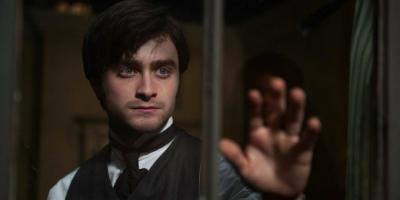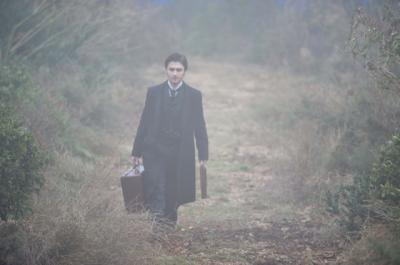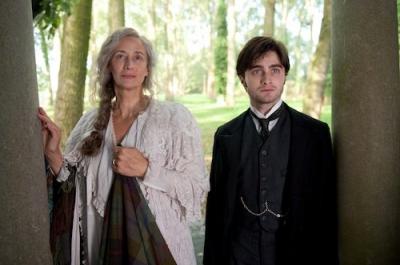By: debbie lynn elias

Daniel Radcliffe fans, never fear! There is life after Harry Potter..albeit dealing with the afterlife. Wielding a more mature type of magic (i.e., his acting skills), with THE WOMAN IN BLACK, Radcliffe casts a spell of suspense and spine chilling thrills that will have you jumping out of your skin faster than you can shout “Illuminata!”
Based on the 1983 novel of the same name by Susan Hill, THE WOMAN IN BLACK has been adapted into a stage play, a radio play and a tv movie, all to great acclaim and success, but none has packed the wallop of a true ghost story until now. With a screenplay adaptation by Jane Goldman, director James Watkins delivers the complete package of ghostly frights and things that go bump in the night, celebrating and utilizing the gothic elements of the Victorian era to full advantage, proving that nothing beats a good old-fashioned spectral scare.
Arthur Kipps is an unhappy man. A young London lawyer, he is also a widower with a young 4-year old son. His wife died during childbirth leaving Arthur to raise little Joseph. But for four years, Arthur has wallowed in his grief. Long noticed by his son, Arthur’s despair is also noted by his employer who advises Arthur that his job is now on the line. With a final warning from his boss, Arthur is sent to the town of Crythin Gifford to settle the estate of a reclusive and mysterious woman. Mr. Jerome, a local solicitor, has been handling the affairs but has been none too prompt or exacting in the matter, thus necessitating Arthur’s intervention. But on his arrival, it is clear that something is amiss. Despite housing arrangements, Arthur is told there is no room at the inn and to get back on the train to London. Why? Townspeople run into their homes and lock themselves behind closed doors when they see Arthur on the street. Why? And then, the local carriage taxi doesn’t want to take Arthur to the deceased’s home inn the remote Eel Marsh. Again, why? In fact there is only one person in town who is friendly to Arthur, Sam Daily, the town’s wealthiest man.

After much haggling, Arthur finally does get his ride to Eel Marsh but once there begins to experience some strange and frightening encounters. A huge manor out on an island that is only accessible at low tide, Eel Marsh bodes dark secrets. In a small family graveyard, Arthur thinks he sees a heavily veiled woman in black. Are his eyes playing tricks on him? In the house, doors slam, antique children’s toys suddenly play music, a rocking chair furiously rocks above him but no one is in the chair. Is Arthur being driven to madness? Is someone trying to frighten him away? On his return to town, local children start dying horrible deaths. And Arthur again sees the woman in black as one child sets herself on fire, erupting into flames and death. Who is this specter? And what does she want from Arthur?
With the help of Sam, Arthur sets out to solve the mystery of Eel Marsh and THE WOMAN IN BLACK. But will it be in time to stop any harm from coming to little Joseph who is on his way to meet his father in Crythin Gifford?

For anyone who saw “The December Boys” several years ago, you knew then that Daniel Radcliffe had talents beyond being a boy wizard, talents which Radcliffe has methodically and carefully cultivated so that now, with his first post-Harry Potter film, he has the maturity and skill to deftly navigate a story of which he is on screen alone 90% of the time. At first blush, one still sees the young Harry Potter as a black crow flies from a chimney in attack mode. But as dawn starts to turn to dusk, and shadows and darkness consume Eel Marsh, memories and images of Harry Potter vanish and one is looking spellbound at a truly frightened Arthur Kipps, clutching candles in his hand as noise rains down on him from throughout the house. Radcliffe is luminous at expressing fear through his mannerisms, his facial expressions and particularly, his eyes which glisten against the darkness. You feel his fear. And with every step taken by Radcliffe’s Arthur, one holds their breath and their heart, knowing in mere moments all will be scared to death. Notable is a visible emotional growth within Kipps, the same type of maturing we have watched unfold with Radcliffe oh these many years. While it seems unsettling and even strange to see Radcliffe play a father, just one scene with Misha Handley and even that relationship feels “right.” Adding to that level of comfort is undoubtedly the fact that Handley – an absolute charmer – is Radcliffe’s real-life godson.

Rejoining Radcliffe on screen is former Harry Potter co-star, Aberforth Dumbledore aka Ciarin Hinds. A masterful actor, surprisingly this is Hinds’ first ghost story or “horror” film he has done in his storied career. As Sam Daily, Hinds plays Devil’s Advocate to the townsfolk and Kipps, doing his best to assuage theories of ghosts and voices from the beyond. He brings a great calm to the character which perfectly compliments the fear and terror rising in Kipps. Adding to Hinds’ presence is the excellent use of lighting by director Watkins and cinematographer Tim Maurice-Jones, which is great contrast to that surrounding Kipps and Eel Marsh.

Janet McTeer shines as Mrs. Dailey, a woman who lost her child and now showers all of her attention on two little dogs whom she dresses in sailor suits (just like her little boy) and sits them in high chairs at the dinner table, hand feeding them with silver spoons from bone china bowls. McTeer is pivotal to the plot and excels at creating her character’s own ambiguity in the grand scheme of things, adding more mystery to an ever thickening plot.
Tim McMullan as local solicitor Mr. Jerome adds to the “creep” factor of the community along with the other cast of character actors, all of which plays into well placed ambiguity within the story.
Written by Jane Goldman, the woman who gave us “Kick-Ass” and last summer’s thriller The Debt” which also starred Ciarin Hinds, she retains the integrity and suspense of the Hill novel, but expands the character of Mrs. Dailey, increases the amount of and intensity of supernatural occurrences, logically alters a few key scenes and, together with director James Watkins, makes THE WOMAN IN BLACK a truly sensory experience on every level. Notable is that dialogue leans more toward the 21st century than the 19th, something that I think will allow for more viewers to embrace the story, while still retaining the vitality of an anticipatory experience. Particularly effective is Goldman’s introduction of Joseph Kipps at a much earlier stage of the story than that in Hill’s novel. She also creates a much talked about ending that is open to individual interpretation.

Director James Watkins blows my mind. His vision is exemplary and his execution as close to perfect as one can ever imagine. Between Watkins and Ti West, ghost stories premised on the anticipation of fear rather than gore and guts have found their way back onto the big screen and into our hearts. I have long been a firm believer that one’s imagination can create more terror than anything blatantly put into a visual and that’s just what Watkins does with THE WOMAN IN BLACK. He fuels our individual imaginations, preying on our individual fears. Where Watkins truly excels, however, is with his energy and pacing which, when sustained, just fuels the terror both on screen and off. What could have been routinely predictable is thrown off-kilter thanks to the editing and scene pacing, not to mention the little monkey wrenches of ambiguity he creates that cause the audience to wonder, setting up numerous psychological paths upon which terror can follow on personal levels.

As I mentioned above, Tim Maurice-Jones’ cinematography is brilliant. Immersing us in shadowed darkness at Eel Marsh, cold steely greys of the English rural seaside and then surprising us with sunlight and ethereal lightness at the Daily home and in Kipps’ visions of his deceased wife, Jones strikes a visual tone that fuels the . The cinematography allows us to feel the heaviness of not only Kipps’ emotional burden but the torment and loss of THE WOMAN IN BLACK herself. Fueling the ambient nature of the film and the anticipation of horrific things to come is the editing of Jon Harris. Harris knows a thing or two about not only creating suspense with cuts and pacing, but working hand in hand with a cinematographer to the greatest effect, having done so with the indelibly frightening “The Descent.” Playing beautifully to the work of Jones and Harris is that of production designer Kave Quinn who I can only imagine had a field day designing Eel Marsh Manor from the furnishings and apportionment of the walls, ceilings, light fixtures and doors to the downright creepy wind-up toys of the era. I also noticed that Quinn and company favored the use of deep, rich colors in the actual decor of the house – plums, deep deep blood orange reds, black purples, aged dark oak and walnut – all of which lend themselves beautifully to the play of light and shadow as opposed to flat blacks and greys. It all gives Eel Marsh House a life of its own.

And let’s not forget Marco Beltrami’s score which provides another subtle , yet creepy, layer of suspense, always lurking in the shadows, fueling the heart-pounding anticipatory terror.
Be afraid. Be very afraid of THE WOMAN IN BLACK. It will scare you to death.
Arthur Kipps – Daniel Radcliffe
Sam Daily – Ciarin Hinds
Mrs. Daily – Janet McTeer
Joseph Kipps – Misha Handley
Directed by James Watkins. Written by Jane Goldman based on the novel by Susan Hill.











